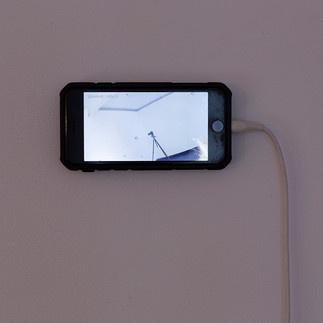Dancing Teddy (2023-2025)
- Eunjung Son

- Oct 2
- 2 min read
Synthetic fur, CCTV, monitor, motor, steel, foam, leather, buttons
Dancing Teddy was first created during an especially cold winter, pronounced by my abstinence from the hedonistic lifestyle I had led. In this period of isolation, I found myself yearning for the warmth of a lover, extending into the innocent comfort soft toys provide.
This longing led to the creation of a two-metre tall teddy bear, embodying both mythological and modern associations with object companions. Inspired by the Greek myth of Pygmalion, whose statue Galatea is brought to life by Aphrodite, I also draw parallels with contemporary iterations, such as sex dolls. The bear becomes a site of inquiry into the unstable distinction between subject and object.
More than a comforting figure, the bear functioned as a security device and a witnessing eye, confirming my existence when I lived alone. I was inspired by the Korean reality TV show I Live Alone, where celebrities are observed with cameras in their homes. The show’s mascot, a teddy named Wilson—modelled after Cast Away—has a camera in its eye and is often greeted or embraced by participants, signalling consent to being watched. Growing up with this show, I imagined myself as one of its subjects, and wondered about the human need to be witnessed, especially when alone.
Do we truly exist if no one is there to perceive us? The need to be witnessed, to have our existence affirmed by another, seems as much fear as desire. Dancing Teddy also reflects South Korea’s molka (hidden camera) epidemic, where women are secretly recorded in bathrooms and public spaces, a violence bound up with patriarchal control. In contrast, cam-girls and streamers reclaim visibility on their own terms, monetising their image and shifting agency.
The teddy’s movements mimic the viral #zerotwo dance popularised by South Korean BJs (Broadcast Jockeys) on AfreecaTV. I humorously refer to myself as a “teddy pimp,” the bear standing in for me as performer. Because it is an object—a robot—the ethical dilemmas of performance and exploitation shift. The Czech root of “robot,” robota, means “serf labour” or “drudgery”: a reminder of how service and performance are entangled with our fantasies of freedom.
Through Dancing Teddy, I explore the tension between innocence and surveillance, between being comforted and being watched. The work asks whether our desire to be seen can ever be untangled from the structures that commodify us, or if, like robots, we remain in service to them.












Comments